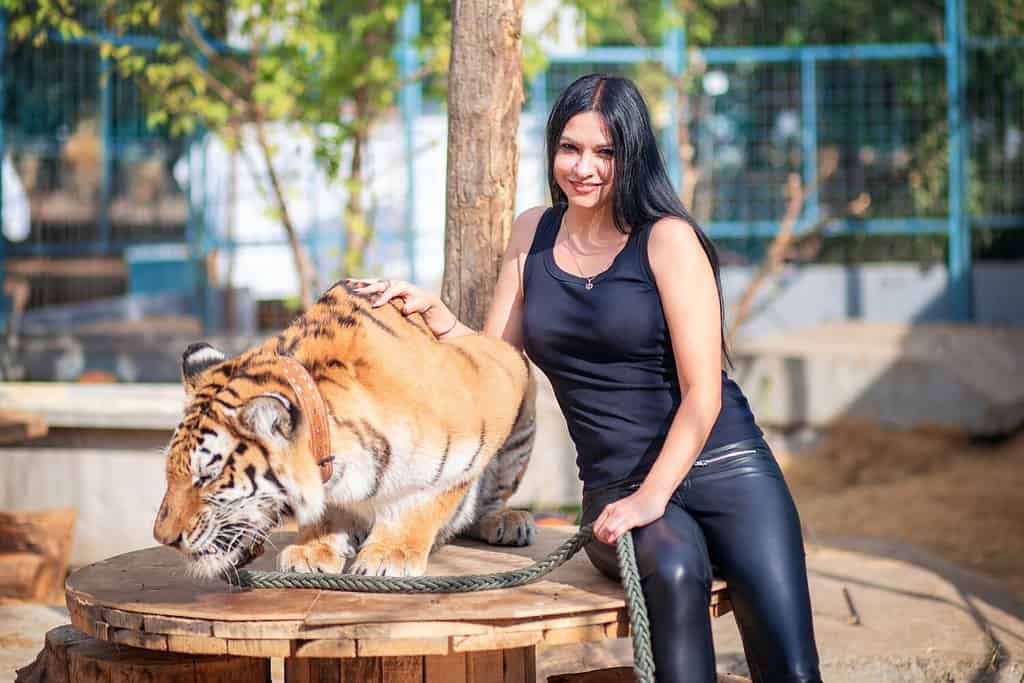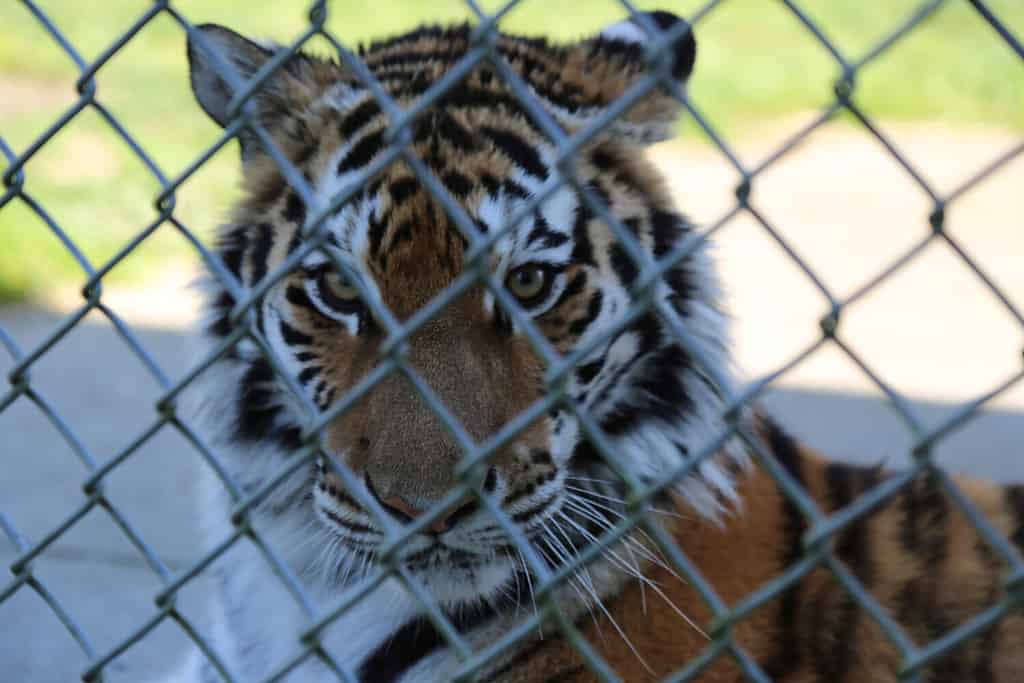When I was little, my favorite animal was the tiger. Everyone knew it, and I got a lot of tiger-related stuff for Christmas and birthday gifts. That fascination didn’t go away when I grew up. So, when I found out a private zoo was bringing baby tigers to a local mall in Cincinnati for photo-ops, nothing could have stopped me from loading the kids in the van and running over there to PET THOSE TIGERS!
Costly, But Worth It?

The chance to safely pet a large cat is a once-in-a-lifetime experience people pay big money for.
©borisenkoket/Shutterstock.com
It was pricey. We dropped a cool $200 to sit in an enclosure with two lethargic cubs and take photos for a few minutes. I told myself it was for the kids but of course, it was for me. The cubs were pretty heavy, so it felt more like holding an adult raccoon than a cat. One of them had a shaved patch on its fur for some medical reason, so we could see that the striped pattern was not just in the fur but on the skin itself. So, we did learn a couple of things.
Leaving, we walked past a long line of other families waiting their turn. In the back of my mind, I thought about how tired and sore those cubs must be at the end of a long day. But I filed that unwelcome thought away (along with the price tag) in a place marked “Yeah, let’s just not think about that.”
Another Side of the Story

Private zoos are often not able to provide habitats for tigers that sufficiently mimic their natural habitats.
©Apsara Photo/Shutterstock.com
Ten years later, my then-teenage son and I were driving across Oklahoma, reading billboards out of boredom. A giant tiger image on one of them advertised the (now-defunct) Greater Wynnewood Exotic Animal Park. Of course, we stopped and paid the admission fee. I had never seen so many tigers in one place! Multiple animals walked around in larger enclosures; others were kept in smaller ones by themselves. All were adults and I wondered why it was necessary to have so many big cats in one place. Wouldn’t it be better to keep just a few in a better living space?
Putting it All Together
These two experiences seemed unrelated until, in 2021, the streaming true crime story Tiger King: Murder, Mayhem, and Madness became a national sensation. Like the rest of the country, I was fascinated by the story of Joe Exotic, his over-the-top lifestyle, and his murderous vendetta against Carol Baskin, a rival eccentric tiger-keeper. And then I put it together: the park we visited in Oklahoma was Joe’s. And the cubs we petted in Cincinnati? Those were Joe’s too. We had supported the Tiger King twice, and in the process, the neglect and abuse of tigers.
Why I Would Never Do It Again
Joe Exotic is sitting in prison now for hiring a hitman to kill Carol Baskin and his zoo has closed, but all over the country thousands of private citizens and small zoos still keep tigers. In fact, there are over 5,000 tigers in captivity in the United States, which is more than the total world population of tigers still in the wild (4,500). And people continue to pay to see them and take pictures with them. Here’s why it’s not a good thing to support these businesses:
Unpredictability
Larger animals can still be unpredictable and inflict life-threatening injuries when startled. For example, entertainers Siegfried & Roy worked successfully with tigers for decades before Roy was critically injured during a performance in 2003. Even before they are one year old, tigers get big enough to knock down a person and inflict serious injuries. Knowing this now, I wouldn’t risk letting my preschool children handle an animal with claws, teeth, and wild instincts.
Irresponsible Breeding

Overbreeding and inbreeding of tigers is one of the problems with these organizations.
©Igor Anfinogentov/Shutterstock.com
Most people want to pet adorable (and safer) cubs instead of adult tigers. This creates a financial incentive for the constant breeding of tiger cubs. That’s why Joe Exotic’s Zoo had so many ill-cared-for adult tigers. And why he allegedly killed some healthy adults that he could no longer afford to feed. It’s a vicious cycle.
Genetic Degradation
You might think that breeding lots of tigers is a good thing and that it ultimately helps save the species. However, tigers bred in captivity are unsuitable for release into the wild because they were not raised in nature and trained to hunt by their mothers. Thoughtless overbreeding also results in inbreeding. The lack of diversity in domestic tigers’ family trees weakens their genetic code and makes them unsuitable to interbreed with wild stock that does not have the same genetic weaknesses from inbreeding.
Health Problems
Tigers are subject to the same feline diseases as house cats. If they are not properly vaccinated, they can catch these diseases from domestic cat owners who handle them. It’s difficult to find veterinary care for large cats in many parts of the country. Nutrition is a problem, as an adult tiger eats 10-25 pounds of meat a day which needs to be supplemented to make sure the animal is getting all the nutrients it needs. They need a habitat and enrichment toys and activities to provide exercise and play opportunities. Private zoos and private owners often do not have the funds or expertise to provide all the proper care for a tiger.
It’s Selfish and Sad

Tigers doing unnatural tricks or otherwise having their behavior modified to suit humans is rather sad.
©SGr/Shutterstock.com
Most of all, I would never do it again because I realize deeply now that my only motivation was to please myself. I wasn’t thinking about what would be best for my children or the animals. I now think my choice was selfish and unnecessary. In the end, it’s a profoundly sad thing for a magnificent wild animal to be caged and deprived of the ability to live in the wild, just so that people can be briefly entertained and take a few selfies, before seeking their next momentary thrill.
Some Good Alternatives

Tigers in their natural element, like this
Siberian
tiger, are more magnificent than tigers in captivity.
©Vaclav Sebek/Shutterstock.com
So, what are some good alternatives for a person who genuinely cares about the welfare of the species?
- Only visit tigers in highly-rated zoos. Resist the urge to put money into roadside attractions, circuses, or other entertainments that do not provide the quality care exotic animals need.
- Admire and learn about the species through books, videos, and other media. Make yourself an expert on them and share what you learn with others.
- Contribute financially and volunteer time to reputable tiger conservation and rescue operations like the World Wildlife Fund.
- If you want to see tigers in their natural habitat, go on an eco-safari with an organization like Wild Sumatra. A three-to-five-day trek into the rainforest is much more memorable and educational than sitting in a cage and taking pictures for a few minutes.
If, like me, you’ve made some mistakes with animals or organizations you’ve supported, there’s no need to wallow in guilt. Just learn from it, do better, and tell others.
The photo featured at the top of this post is © Eric Isselee/Shutterstock.com
Thank you for reading! Have some feedback for us? Contact the AZ Animals editorial team.







